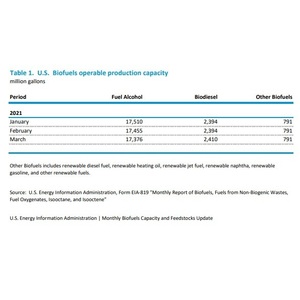EIA: Biofuel capacity falls slightly in March, feedstock use up

June 1, 2021
BY Erin Krueger
The U.S. Energy Information Administration released data on May 28 that shows 20.577 billion gallons of U.S. biofuel production capacity was in place in March, down slightly from 20.64 billion gallons in February.
Fuel alcohol production capacity was down for the period, falling from 17.455 billion gallons in February to 17.376 billion gallons in March. Biodiesel capacity, however, increased from 2.394 billion gallons in February to 2.41 billion gallons in March. Capacity for other biofuels, including renewable diesel, renewable heating oil, renewable jet fuel, renewable naphtha, renewable gasoline and other renewable fuels, held steady at 791 million gallons.
Advertisement
Approximately 23.499 billion pounds of corn went to biofuel production in March, up from 18.717 billion pounds in February. The EIA data shows no grain sorghum was used to produce U.S. biofuels during the month.
According to the EIA, 43 million pounds of poultry fat, 83 million pounds of beef tallow, 64 million pounds of white grease, 226 million pounds of yellow grease and 9 million pounds of other waste oils, fats and greases went to biofuel production in March, compared to 34 million pounds, 66 million pounds, 50 million pounds, 198 million pounds and 3 million pounds, respectively, in February.
A total of 123 million pounds of canola oil was used to produce biofuels in March, up from 85 million pounds in February. Corn oil use was also up, at 195 million pounds, compared to 155 million pounds in February. An additional 740 million pounds of soybean oil went to biofuel production in March, up from 552 million pounds the previous month.
Advertisement
A total of 69 million pounds of other recycled feeds and wastes and other biofuel feedstocks were used to produce fuel in March, compared to 63 million pounds in February.
Related Stories
The abrupt closure announcement by Biox Corp. is the latest example of a failure to secure Canada's domestic energy supply, says Unifor. The Canadian energy union is advocating for simply regulatory changes that could help restart the facility.
Domestic production of SAF to meet 30% of New Zealand's jet fuel needs by 2050 could generate NZD 1.3 billion in GVA and create 5,700 jobs, while also strengthening fuel security, according to a Cyan Ventures study supported by Boeing.
The Civil Aviation Decarbonization Organization, and 4AIR announced a strategic collaboration between their respective SAF registries. The collaboration's key focus is on interoperability to enhance data integrity and mitigate double issuance risks.
Chevron Lummus Global announced a successful commercial test for coprocessing biogenic feedstocks and fossil feedstocks at INA Group's Rijeka Refinery in Croatia. SAF and renewable diesel were produced during the test.
Phillips 66 on July 25 released Q2 financial results, reporting the company’s Rodeo Renewable Energy Complex in California continues to run at reduced rates due to market conditions. Pre-tax income for the renewables segment was up when compared to Q1.
Upcoming Events










